Original manuscript dated 1 October 2003.
It was later reorganised with minor modifications and left unfinished in March 2004. Published on this site 29 July 2010.
A number of people supported David to produce this and other manuscripts during 2003 and the beginning of 2004 (see also David Grove: history of work 1980-2004). The people I know who helped include his dear friends: Sandy Hall (Pepperell), Rob & Brenda McGavock, John & Jenny Mote, Anna & Bruce Norris.
If you know of anyone else, and especially if you have copies of any other source material of David’s work please let me know.
I have made a few typographical edits and inserted what I think are the relevant DG’s drawings and references, otherwise the content of this document is as I found it on David’s computer.
James Lawley, 29 July 201
Contents
1. Clean language
1.1 Clean questions
1.2 Seduction, language that complicates issues etc
1.3 Retraumatising / crying
1.4 Gathering information with clean language
2. Clean space
2.1 Physical space
2.2 Mission statements
2.3 The observer, the observed and the space in between
2.4 Sweet spots
2.5 Find a space
3. Inner child
4. Metaphor
5. Small world networks
5.1 A network solution
5.2 Adjacency
5.3 The significance of the off beat
5.4 Weak ties
6. Memories
6.1 The figure and the ground
6.2 Defining and building up the memory
6.3 Defining moments
6.4 Developing questions
6.5 Plane of bisection
6.6 Child without / child within
7. Problems and solutions
7.1 Problem domains
7.2 Chicken and egg solutions
8. Pulling back
8.1 Pulling back time and space / T-1, T-2
8.2 Pulling back the person / use of nouns and adjectives
8.3 The pristine noun
8.4 The historical adjective
9. Ancestry
10. Ontology
10.1 I queues
10.2 Sense of belonging
10.3 Mission and purpose in life
10.4 The ‘I’ pronoun
10.5 From whence you came
11. Cosmologies
11.1 Cosmological orders
11.2 Positions 1-6
11.3 Plane of bisection
12. Boundaries and edges
12.1 Boundaries
12.2 Clues to boundaries
13. Strangely scaled worlds
13.1 Strangely scaled worlds
13.2 Role of stories
13.3 Landscapes
14. Complexity and emergence
14.1 Complicating issues
14.2 Emergence
15. The body physical
1. Clean Language
All language triggers reactions, only some of which appear in the listener’s consciousness. How therapists use language, largely determines the way they conduct therapy.[Metaphors in Mind: Transformation through Symbolic Modelling, James Lawley and Penny Tompkins, 2000] The concept of clean language is the result of exploring the influence of language through clinical interactions:
The first objective is for the therapist to keep the language clean and allow the client’s language to manifest itself. The second objective is that the clean language used by the therapist be a facilitatory language; in the sense that it will ease entry into the matrix of experience, and into that altered state that may be helpful for the client to internally access his experience. …
By asking clean questions we shape the location and the direction of the client’s search for the answer. In asking a question we do not impose upon the client any value, construct or presupposition about what he should answer. …
The client is free to find an answer and may keep the answer to himself. It may not be necessary for the client to share his memories, thoughts or feelings. … The questions are not asked to gather information or to understand the client’s perspectives. We ask our questions so that the client can understand his perspective internally, in his own matrix. … We want to leave our questions embedded in the client’s experience. …
Our questions will have given a form, made manifest some particular aspect of the client’s internal experience in a way that he has not experienced before.
[Resolving Traumatic Memories: Metaphors and Symbols in Psychotherapy, David Grove and Basil Panzer, 1989: pp. 8-10]
[See also David’s: The Philosophy and Principles of Clean Language, 1998]1.1 Clean questions
Clean questions are clean, simple and repetitive. The small iterations, repeated over and over are what make the questions powerful.
Clean questions do not introduce ideas to the client or ask the client to expand on the details of their problems. Clean questions use only words the client has already said and repeats only a set number of question styles which are small iterations that can be asked over and over.
When questions are kept clean the client’s own model of the world is able to come out and the solutions come from within them. When questions are repetitive its predictable what the next question will be so the client isn’t involved in trying to out guess the therapist or the next question.
For example:
And what kind of … would that … be?’
And is there anything else?’
1.3 Retraumatising / crying
When unclean language is used, or when the forward motif occurs, a client may be retelling or reliving the trauma. Asking ‘what happened next?’ or asking them to expand on the information may increase the possibility of re-traumatising the client. The traumatic experience is about them being disempowered and when they are asked for more information they may find themselves back in the story and replicating the same conditions that occurred during the traumatic experience where they have no control over the situation or their feelings. Crying may also occur at this time.
Crying at the point where the client is telling the story could be harmful. These would not be cathartic tears. Cathartic tears would usually occur at the end of something, not in the middle. They would be the result of a realisation on the inside that something has healed and changed.
1.4 Gathering information with clean language
For the client to resolve issues they will need to gather information that will help them to see different perspectives on the events that have occurred in their life.
As explained above, asking questions that will require the client to retell events and expand on information is asking them to give the perspective they already have. This information is unnecessary.
Instead of causing the forward motif where the problem space moves forward in time, information can be gathered by pulling backwards to a different space. This may involve pulling back either the person (pulling back to find the pristine) or pulling back time and space.
2. Clean Space
The idea of working with space, physically moving and using the space within a room, is that there is valuable information to be gained by asking questions of objects and spaces, rather than focusing on the client. This relieves the client of responsibility and gives the client different perspectives on events in their life.
2.1 Physical space
Clients are able to download information that they know, at certain points in the room. When they move to another space, they effectively leave behind part of themselves in the previous space. This way they are removed from who they were in that space and removed from how they felt in that time and space. They are in a different cosmology. Once they move, they are able to view who they were in that space and they now have a different view and different information to download.
Clean space refers to the notion of physically moving a person to a different position in the room where they can view events from different perspectives.
It can be very difficult to move someone to another space emotionally, but actually making the person move to a different position in the room can achieve the same objective, sometimes quicker or easier.
For example, a person may be in a position where the trauma is occurring and it can be difficult to move them emotionally from that space, but by just turning the person around they may find themselves in a different emotional space.
What also happens is that when a person is in one space, they are able to view another space as if it is a different cosmology, so they are not only being able to view events in their life from different cosmologies or perspectives, but the space actually makes a cosmology tangible, so they can look back to a space and feel they are actually looking at that cosmology and the events that occurred in that time period are kept in that space. Part of the person themselves, their mental space or mental body stays anchored in each space so that when they get up and move, part of them doesn’t leave.
In this way information is able to be downloaded into a space, giving the space knowledge which can be drawn on and developed when the need arises.
If a person remains in the same position (for example if they always sit in the same seat when they are with a therapist), they may never progress in a healing sense because they only know the problem as it is in that space because that space keeps that information in that world and it is never looked at from a different perspective. As long as a person stays in their original position their problems will always be configured in the same way.
Spatial techniques refer to the use of physical space in a room, for example, the use of mission statements [2.2], finding a space [2.5], and adjacency [5.2].
2.2 Mission statements
A mission statement is used as a focal point when beginning a session using spatial techniques. It is a statement written on a piece of paper and placed somewhere in the room. The client then stands in a position in respect to the mission statement.
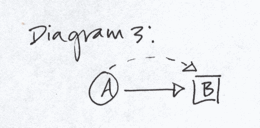
The statement can be anything, it doesn’t really matter. It can be a goal or a wish or a need. The client may not have any idea what any of these things are, then they can write something that seemingly has no relevance to them at all.
To help the client choose what to write, ask them ‘what do you want?’, ‘why did you come here?’. Sometimes they don’t know. Ask them to put on the paper what the paper wants to have put on it. This takes the responsibility away from the client by dissociating them from having to come up with something.
The scale of the mission statement is important. It might be written in large letters or it might be so small that it’s almost impossible to see it. Then the placement of the statement is also significant and finding where to stand. The person may have their back to it or they may even sit on. Some will have it so far away that they have it in the next room as if it’s something they could never accomplish and others will have it just out of reach.
The mere act of processing these thoughts and making these decisions about the mission statement can be a complete microcosm of how a person lives their life. All of their issues can come up in this one simple act.
2.3 The observer, the observed and the space in between
Writing a mission statement sets up a situation where there is an observer (the client), the observed (the mission statement) and the space in between.
When the observer chooses the place they want to sit or stand in respect to their mission statement, they are placing themselves in position 1 (P1) where they are the person who knows what they know at the beginning of the session.
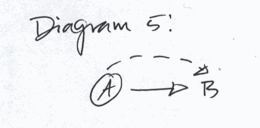
Throughout the session, the client needs to be returned to this position occasionally, because that is the position that defines the edge of their world and is also the problem boundary. They also need to go back to that position to end the session because when they are in a different position they may be in the state of mind where they are at a different age. This makes them dissociated. Returning to (P1) will ensure they are in their right mental state, and a whole person.
The therapist asks questions of the person, the mission statement and of the space in between, in the belief that space holds information as well as the person.
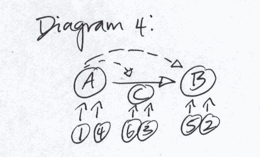
The questions are not limited to what the observer knows because information is valuable no matter where it comes from. If the questions are only ever asked of the observer, there will be very interesting and useful information missed.
When the person is in (P1) anything that they say about the nature of their problem, is likely to be irrelevant to the solution. Their information is not very useful in terms of solving issues because they have the same perspective on their problems as they did when they arrived. As long as the person stays in one position, their problem will always beconfigured in the same way. In (P1) a person may hold a particular view of the world which, as long as they stay there, is true. But if they were asked to move to another space they are then as equally capable of discounting everything they said in the previous position.
When those questions/iterations are exhausted at (P1), the client is then asked to ‘find another space that knows more about…’. This will begin a series of adjacency questions
2.4 Sweet spots
Some spaces will give the client particular insight. These spaces are called sweet spots. They have such a view of the world that they have a different perspective on the nature of their problems and they may continue to talk for long periods of time.
What to do: Wait. Leave the client to download information for as long as necessary
2.5 Find a space
Need to explain this and how it is different to adjacency
3. Inner Child
4. Metaphor
To be written
5. Small World Networks
Adjacency uses the notion of ‘networking’ to find solutions that resolve clients’ issues. Different spaces in a room will hold different information. When a client views another space and the information it holds, they are linking the spaces and the information, thus creating a network of information which in theory should find a solution faster than if one space worked on its own.
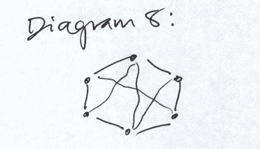
The theory of the six degrees of separation comes from the study that showed that mathematically, among the billions of people throughout the world, there is a probability of finding a connection within 6 people. Therefore, it should take a therapist, on average, six spatial moves to find the link that leads to a solution.
The key to the linkages are the weak ties between the logical steps that one would normally take to find an answer. The weak ties are like short cuts to the solution.
For example if there are 50 points on a circle, you would imagine you have to go through each point to complete the circuit, but if there are a number of weak links in the circle where one vaguely knows another, then all of a sudden you can jump to a place where you only have two more points to reach the end instead of 40.
5.1 A network solution
Adjacency uses the notion of ‘networking’ to find solutions that resolve clients’ issues. Different spaces in a room will hold different information. When a client views another space and the information it holds, they are linking the spaces and the information, thus creating a network of information which in theory should find a solution faster than if one space worked on its own.
The theory of the six degrees of separation comes from the study that showed that mathematically, among the billions of people throughout the world, there is a probability of finding a connection within 6 people. Therefore, it should take a therapist, on average, six spatial moves to find the link that leads to a solution.
The key to the linkages are the weak ties between the logical steps that one would normally take to find an answer. The weak ties are like short cuts to the solution.
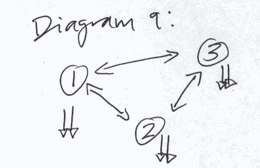
For example if there are 50 points on a circle, you would imagine you have to go through each point to complete the circuit, but if there are a number of weak links in the circle where one vaguely knows another, then all of a sudden you can jump to a place where you only have two more points to reach the end instead of 40.
The weak links are the key to making the network phenomenon work. It’s not what you think is going to work, but some offhand or obscure remark, if picked up on, could take a client to a perspective they haven’t seen before. This could bring them closer to a solution than they might be if the most obvious line of inquiry were followed.
The movement between adjacent spaces coupled with the use of simple iterations, over and over, will allow the therapist to merely guide the process and a network solution will occur.
5.2 Adjacency

5.3 The significance of the off beat
To find a rhythm, the spacing between the beats is more important than the beat itself. When something is on a beat, it’s a march and when it’s off beat it’s a dance. Military cultures may oppress the people with a march, whereas the oppressed will take that march and put an offbeat in it and that is their expression.
The off beat is not the next beat, it’s the adjacent beat that lies in between. So when you are looking for a solution, that which is the next thing, is not what will work. The next thing makes sense because it is logical but it will keep the client in the same cosmology. The space in between or an adjacent space is what will provide the clues to get to the edge and then the other side of the cosmology where the solution space is.
5.4 Weak ties
Weak ties are the offhand comments or obscure gestures that might go unnoticed. For example, a word that’s repeated or a wave of the hand. The client might believe that they mean nothing but, if the therapist picks up on these comments or gestures, they might find that they lead the client closer to the edge of the cosmology.
What to do: Ask ‘What kind…?’
6. Memories
6.1 The figure and the ground
While the focus naturally leans towards the figure or the subject dealing with the trauma, it is important to also be mindful of the ground or the inanimate objects that the client mentions in their description of the trauma. By treating the figure and the ground with equal importance you will not limit the resources available for healing, because the person in the trauma may be the least resourced part of the experience. As well as pulling the figure back in time or space, you can ask questions of the ground and pull back time or space in that way. By asking questions of the ground, it will animate and vivify those elements and provide healing solutions.
For example if the person says that an experience occurred beside a lamp post, the question could be asked, ‘where did the lamp post come from?’ or ‘what kind of lamp post is that?’ and it might take the client to a new observation platform and a different perspective on the experience.
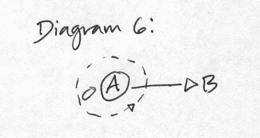
The reason the ground is important is because when a person recalls an experience, they can often remember such exquisite detail as the pattern on the carpet or the wallpaper (when they can’t remember most of the other years of their life). This is because parts or fragments of the person has been embedded into that ground so that it is as much a part of the experience as the person is in that memory. Asking the questions of the objects will bring them to life and the part of the person that dissociated or fragmented into that image will also come out.
6.2 Defining and building up the memory
The pulling back questions have done the work of finding the time before the trauma or finding the pristine. What needs to occur at this stage is to define and build out that memory so that the person has a complete picture of who they were before the trauma occurred.
The questions that will do this are called developing questions:
‘What kind…?’ ‘Is there anything else?’
What will happen is the person who is about to experience the trauma is put back into a context where they can look forward at the experience through a new set of eyes. These questions can be asked repeatedly until there is nothing left.
To build up the pristine the questions go specifically to the figure:
‘What would you be wearing?’ establishes the body of the person. ‘How old would you be?’ establishes time.
6.3 Defining moments
If it’s a defining moment, the person will be able to describe their clothes and whatever else is there in intimate detail because these moments will be remembered. If they can’t, then it isn’t the pristine and you may have to pull back further. Once the figure has been established, questions can be asked of the ground at this point too.
6.4 Developing questions
Developing questions should be used to build up a positive space you want the client to remember. Questions can be asked of the person or the ground. These questions will establish time and establish the body of the person.
Establishing time – ‘How old could you be when… ?’
Establishing the the body – ‘What could you be wearing when…?
‘What kind of….’
‘And is there anything else about….?
6.5 Plane of bisection
To be written
6.6 Child without / child within
To be written
7. Problems and solutions
7.1 Problem domains
A problem domain is defined when a client expresses a notion that they have a specific problem and they describe it with themselves as part of it. They are in a problem space, defined by a boundary. For this purpose it is called an egg-type problem.
[See also David’s: Problem Resolution through Metaphor Therapy, 1998]
7.2 Chicken and egg solutions
In the course of a session, you may find that as fast as solutions are occurring, more problems are arising. The client is working within a boundary where problems and solutions are of the same type. These are egg type solutions to egg type problems. The client needs to get out of that boundary to the solution space on the other side – the chicken solution to an egg problem.
When the therapist then works within the boundary of the problem domain, they will be looking for egg-type solutions. When a traumatic experience is the issue, and it is worked on within its problem domain, the issue may seem to be resolved and some healing will occur but soon the next issue will arise. It may be surprising that the resolution of the first issue hadn’t had more of an effect on other issues in the person’s life. Egg solutions will only solve egg problems. What’s needed is a solution that encompasses all the eggs. This needs to come from outside the boundary, in other words, a chicken solution.
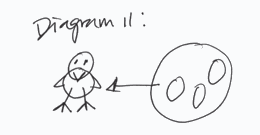
To find the chicken solution, the difficulty is getting outside of the boundary the eggs are in. The techniques of clean language and space will do this by either pulling the person back in time and space or by physically removing the person from the problem space (where they are sitting in the room).
The client starts with a problem set, or a particular class of problems and the solution set will be in a completely different cosmology. This is how the concept of space works. It will move the person out of the problem domain.
8. Pulling Back
The idea of pulling back is like the archer. In order for the arrow to hit its target with accuracy, the bow needs to be stretched and the arrow needs to be pulled back to just the right distance. The question is, how far do we pull back, in order to hit just the right spot?
Pulling back will find either the Pristine (P3), the place where they felt right or scaled to their world, or T-2, the time and space where the client was, just before feeling bad. If the pristine is not found, the client may need to find (P6) From whence they came.
8.1 Pulling back time and space / T-1, T-2
To arrest time and stop a person from moving forwards or falling into affect, they need to find a different space from their problem space. This will place them in a more empowered position.
A client’s problem space is where they are focused on the trauma and the events that occurred. When they begin to talk about the trauma they will be in a time period which begins just before the worst moment occurred. This time period is called T-1. It is characterised by the use of words ending in ‘ing’ which makes the problem ongoing.
To move the client out of their problem space they need to find the space which is just before T-1. This is the time before the trauma occurred, T-2.
Moving time back to T-2 will help move the client out of their problem space and will allow them to gather information from another perspective without complicating the issue.
Starting a session from the T-2 position is a better place to start than the T-1 position because at T-2 the client feels more empowered.
At T-1 they are going to tell the therapist all about what happened to them. At T-2 they are not yet involved or embroiled in what happened to them. They are able to look forward at what happened, giving them a new perspective. They are looking forward in retrospect. Being able to look at the event from a space where it hasn’t happened yet doesn’t hurt as much and the client is a better resource than they were in position 1 where the trauma is a part of them.
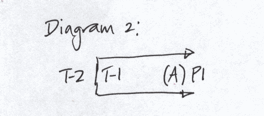
When moving time back there are also elements of space that need to be considered. Time and space are interchangeable. When a person is traumatised in space they feel it in themselves. When they are traumatised in time as well, they may indicate this by reliving their experience at a certain time of the day.
The question that pulls time back is: ‘What happened just before…?’
The question that pulls space back is: ‘Where did … come from?’
The memories will be fixated so it requires perseverance from the therapist as it will be very difficult to move time back because it will want to go forward.
When asking the questions to move time back, they may become overwhelmed and say ‘I don’t know’. This is when the space questions would help the move backwards. They provide more information that work like another observation point.
For example: If the client is asked ‘where did the man come from?’ and the client answers ‘well, the parking lot’, then there is new information and the man has been pulled out of the experience.
8.2 Pulling back the person/ use of nouns and adjectives
To pull a person back there are two ways that you can go – with the adjective or with the noun.
For example, if a client communicates something about themselves such as, ‘I come from an alcoholic family’, the line of enquiry would usually follow the adjective. In this case we would find out the evidence that they do in fact come from an alcoholic family and all the issues that are raised will be laid at the door of alcoholism and it will uncover a lot of family history.
If the noun is detached from the sentence and the line of enquiry follows the ‘I’, what will be uncovered is who that person is when they are not part of an alcoholic family.
The question that pulls the noun back is: ‘What kind of you were you before…?’
The way of the adjective = genealogy
The way of the noun = ontology (I am)
By pulling the person back with the use of the noun, you are able to find who they were before they were affected by events in their life. This is different to pulling back time or space because finding out ‘who’ they were is not the same as ‘where’ they were or ‘what’ they were doing. They are finding out the very nature of their being, their ontology or their ‘I am’-ness.
To find who they were, they need to be pulled back to a time in their life when they felt right in the world – when they were scaled just right for the world or at one with the world. This time period is called the Pristine.
8.3 The pristine noun
Only the noun will take the person back to the pristine.
The Pristine noun is a very particular solution space. The definition of pristine is ‘in an unspoilt condition’, which describes the person before they were affected by events in their life. This condition does not last very long because life goes on.
The pristine is usually found between the ages of 0 to 5, by which time a person will lose their adjectival complement, or the phrases they come into the world with. Those phrases might begin with ‘I am young and innocent’ and they might change to ‘I’m afraid’ or ‘I don’t know who to trust’.
Defining moments that knock the pristine could be the first day of school or kindergarten or moving house early on. Also the arrival of a sibling means you are no longer the centre of the universe. When these moments arise, the world is not scaled to you as you know it. When you move outside of the world you know, your cosmology collapses because your world changes and it changes you.
The purpose of pulling back the noun to find the pristine is so that the client can build up a picture of their world in the pristine and find their ontology so that they can take it back with them to their person in position 1, who they were when their session began.
8.4 The historical adjective
To be written.
9. Ancestry
To be written.
10. Ontology
10.1 'I' queues
To be written.
10.2 Sense of belonging
Some clients will not have a sense of the pristine. They are more easily traumatised because they have no sense that they belong in the world. This percentage of people may not have a sense of belonging to the family or culture they were born in to. They may have vivid memories of a time of great anxiety or that they were untimely born or unwanted. They may never have had the perception we are trying to find in the pristine.
It is important to establish this characteristic of a client because when they are being pulled back they may need to go further than where the pristine should be. They may need to be pulled back to the place from whence they came (P6).
10.3 Mission and purpose in life
To be written.
10.4 The ‘I’ pronoun
In the course of the session, the client may be answering questions from the third person viewpoint. When moved to adjacent spaces they may change this view and become the person in the picture. When they do this, they will use the ‘I’ pronoun. For example they might previously have been talking about ‘the girl’ and then they refer to her as ‘I’.
What to do: Ask ‘what kind of you…?’
10.5 From whence you came
People who have no sense of belonging must know what it feels like to belong. In order to say ‘I don’t fit’, they must have had the experience of belonging somewhere else to know that they don’t belong here.
There is an edge of the world or a cosmology in which one thing is so here but not necessarily so somewhere else. There are people who’s pristine is further back than within the cosmology after they were born, but there’s a sense that they came from somewhere. This is the place called ‘from whence you came’.
The question to find out from whence you came is: ‘Where did you come from before you came here?’
11. Cosmologies
11.1 Cosmological orders
Moving a person back in time or space requires them to be in different positions within their self (not physically). These are different times in their life where they know what they know in that period of time only. Each time period is a cosmology. There are six main cosmological orders in a person’s life. Within each cosmology there can be different cosmologies where a person is caught up in a space that only knows what they know in that space from that perspective.
When a person is moved from one cosmology to another, their mind changes, a different world is created and the person is regenesised – the genesis or beginning of their being is reformulated in each cosmology. When we pull out of one cosmology we can find a solution in the other. A different cosmology gives a person a different perspective. In one cosmology a sense of where a person comes from can be different to their sense of where they came from in another cosmology. Your view of your origin may be closer in the cosmology of a 5 year old, than later in life.
11.2 Positions 1 to 6
The six main cosmologies can be mapped out as positions 1-6:
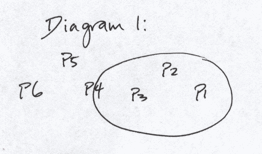
| Position 1 (P1): | The cosmology the person is currently in. This could be the person from aged 5 or more through to now. |
| Position 2 (P2): | The cosmology where all of the problems occurred. |
| Position 3 (P3): | The Pristine. |
| Position 4 (P4): | When the person came into the world. |
| Position 4 (P4): | When the person came into the world. |
| Position 5 (P5): | Before coming into the world. |
| Position 6 (P6): | From whence you came (fwyc). |
11.3 Plane of bisection
To be written.
12. Boundaries and Edges
12.1 Boundaries
Problem domains and cosmologies are defined by boundaries. When a client is at the edge of their cosmology, they may need a push to get them through the edge to the other side where they will find themselves in a different cosmology.

Finding the edge may require several adjacency moves, looking for the right clues. To get through the edge it will require either asking the right questions when clues arise (see next section) or a directive from the therapist such as:
‘Take a step, or move backwards’
12.2 Clues to boundaries
As a client moves between spaces they are downloading information that will work for them on several levels. They are linking parts of their life by viewing events in the past from different perspectives at different spaces. Thus a network is forming. As this process develops they in time will drop a clue that the therapist should pick up on and make the next move towards or through the edge to another cosmology and another solution space. The clues are: …???
13. Strangely Scaled Worlds
13.1 Strangely scaled worlds
To be written.
13.2 Role of stories
A client may mention a story that they identify with. It may be a particular book, cartoon, movie or television programme. These stories are where the client disappeared to at a time in their life when they were experiencing trauma. The cosmology they are stuck in is on this side of the story. The therapist can take the story and find out who the person is who was reading, watching or listening to the story. The time when the story was important to them is the edge that the client needs to move through in order to progress to their destination. They are in a Janis moment, when they can look back or forward from that time, either into the story or back to who they were before they went in to the story.
What to do: Ask ‘what kind of you…? Or direct them to turn around.
13.3 Landscapes
To be written.
14. Complexity and emergence
To be written.
14.1 Complicating issues
Language that draws or seduces a client into a story, complicates issues.
The temptation to want to take information that the client gives and ask for more details or to expand on it is natural, but harmful. The answers will cause a forward motif. They will take time and move it forward and then the problem space also moves forward in time. The problem then becomes more and more dense with information and added to that is the therapist’s perspective on the nature of the problem and this determines the therapist’s questions or lines of inquiry.
As more information is collected, the therapist becomes part of the client’s world and this is a tyranny of the narrative. Questions then become iatrogenic by complicating or adding to the already complicated issue.
A good example comes from the playwright, Willie Russell, who says that to be a playwright you have to use very dirty language which is completely the opposite of clean language. He wants to put words out there that seduce people into his story, so that you lose everything that you have and you become very involved in his narrative.
Clean language works by avoiding introducing words or scenarios, and avoiding asking questions that will make an issue more complicated.
Experience may make a therapist want to take a client’s problem definition and expand it with questions like, ‘what happened next?’ or ’explain more about that’. These questions will move time forward and will make the problem space more dense with information. It will also join the therapist into the same world as the client, causing a seduction to occur where the client is drawn into more problem spaces.
Retelling a story can retraumatise the client and crying at this point could be harmful rather than cathartic. So the skill is to avoid going directly to the time period of the trauma (T-1).
Clean language requires the therapist to be a guide, rather than a facilitator. The discipline is in not asking the questions that the therapist might want to know. The therapist doesn’t need the detailed information about the trauma, in order to help the client resolve issues. Adding the therapist’s perspective will cause the lines of inquiry to go in the direction that interests the therapist, not the client. Clean language will let the client’s model of the world come out and the solutions will come from within that.
14.2 Emergence
To be written.
15. The Body Physical
To be written.








